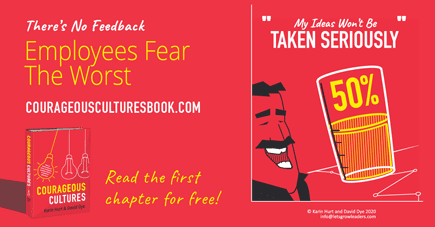Don’t let your people feel ignored.
We were working with a large financial institution that had done an excellent job of cultivating curiosity. They regularly asked people at every level of the organization for their ideas, suggestions for innovation, and solutions. They had a robust system where people submitted hundreds of suggestions every month.
As we talked with Adam, a senior executive about how they used the system, he made an interesting observation: “About half the suggestions we get are ideas that have already been implemented—or are underway.”
“That’s great,” we said. “People must feel good about how they’re making a difference”
He frowned. “Well, not exactly. Our surveys still show people feeling like their ideas aren’t valued.”
As we explored this gap, we asked, “How do you let people know what’s happened with their idea or that it’s already being used?”
He was quiet for a moment. “We aren’t.” And then a rueful grin. “No wonder people don’t feel appreciated for their ideas.”
A Keep ‘em Coming Strategy for Innovation and Solutions
In our research for Courageous Cultures, we found that half of the respondents, irrespective of their level in the organization, felt that their leaders don’t take their ideas seriously.
But from our conversations with executives and senior leaders across a range of industries, we know that innovation and solutions aren’t just appreciated—they’re vital.
Frequently, the gap comes down to how you respond. You may appreciate the many ideas and ways people are thinking about how to be better, but if you never circle back and let them know, they feel ignored.
They’ll assume you don’t value their contributions, don’t take their ideas seriously, and are stuck in your ways.
But you can easily change this dynamic and maintain a steady flow of innovation and solutions when you Respond with Regard.
Respond with regard means that when you receive an idea, you react with gratitude, information, and invitation:
- Gratitude that they cared and took the time to think about how to make things better
- Information about their idea
- Invitation to continue thinking, solving, and suggesting
Respond with Regard

Here’s how responding with regard looks in practice with different types of ideas you might receive:
1. The idea is already being used, or implementation is underway.
Gratitude: “I appreciate you thinking about how we can improve.”
Information: “That was a great idea and we’re already doing it. Here’s where you can learn more …”
Invitation: “I’d love to hear your ideas on how can solve … (a significant challenge).”
2. The idea is half-baked or is incomplete.
Gratitude: “Thank you for taking the time to share this.”
Information: “I wanted to give you some additional information that might help as you’re thinking about these issues.”
Invitation: “I’d love to hear your thoughts on how we might get the outcome you suggested in light of this added information.”
3. The idea is ready to go to trial or testing.
Gratitude: “Really appreciate you thinking this through.”
Information: “Your idea is ready for a test run. Here’s how you can get involved.”
Invitation: “As you’re working on that, I’d love to hear your thoughts on how it might help us solve …(a significant strategic goal or challenge).”
4. The idea isn’t useful now.
Gratitude: “Thank you for thinking about how we can be more effective here.”
Information: “This is a great idea to diversify our customer base. Right now, however, our top priority is improving our existing customer experience and that’s where we’re putting time and money.”
Invitation: “I would love to get your ideas about how we could improve our customer experience.”
Your Turn
When you respond with gratitude, information, and invitation, people know that you value their contributions and they’re much more likely to continue thinking and speaking up with thoughtful innovation and solutions.
We’d love to hear from you: What is one way a leader encouraged you to think deeply and help solve strategic problems?
You can download a FREE chapter of our new book Courageous Cultures: How to Build Teams of Micro-Innovators, Problem Solvers, and Customer Advocates here.









I used to send half-baked ideas to my supervisor all the time. He accepted each one graciously, and I kept sending them. Sometimes I’d actually have a good idea, and he got those as well. If he hadn’t been so receptive to all ideas, I’m sure I’d stopped sending them, and he wouldn’t have received the useful ones.
Cathi, Thanks so much for sharing your story. This is exactly what were talking about. And, I imagine your ideas got better as time went on 😉
Love it Cathi! Thanks for sharing that experience.
My manager gave me an opportunity to teach / present a talk on personalities and how “to gel” together. Instead of doing it in front of a large group, my manager provided a Test Tube group.
The results were great – we honed the talk, made some adjustments, and used it to equip and train some of our customers.
Paul, I love that “test tube group.” Perfect. Thanks for sharing.
Thanks Paul – those trials and tests are so important for giving ideas the best chance to succeed and for everyone to learn all they can. Great example!
This is amazing! The test tube group was exciting! Thanks for sharing this experience….